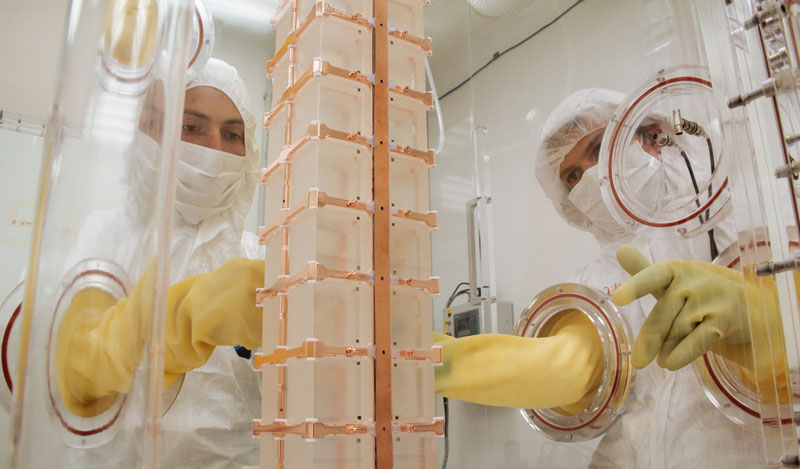
The experiment
CUORE is the largest volume of cryogenic tellurium bolometers ever built. It looks for neutrinoless double beta decay, which is the only way to investigate whether neutrinos are their own anti-particles. The tellurium crystals form both the source material and the detector: a radioactive decay of 130-Te is detected when a crystal heats up minutely. All 741 kg of the crystals, plus the associated support structures, are cooled to about 10mK in a cryostat that uses a dual-phase helium dilution refrigerator. The location in the underground Gran Sasso National Laboratory cuts out any background from cosmic rays. To further shield the detector from any outside interference, CUORE uses a layer of ancient Roman lead that was retrieved from a sunken ship by physicists and archeologists. Prototypes for CUORE are already producing world-class results about nuclear interactions, and CUORE will be one of the definitive neutrino experiments of the decade.
The crystals
The cryostat
The Roman lead
Collaboration
C.Alduino1, K.Alfonso2, D.R.Artusa1,3, F.T.Avignone III1, O.Azzolini4, M.Balata3, T.I.Banks5,6,3, G.Bari7, J.W.Beeman8, F.Bellini9,10, A.Bersani11, D.Biare6, M.Biassoni 12,13, C.Brofferio 12,13, A.Buccheri 10, C.Bucci 3, C.Bulfon10, A.Camacho4, A.Caminata11, L.Canonica3, X.G.Cao14, S.Capelli12,13, M.Capodiferro10, L.Cappelli 3,15, L.Carbone13, L.Cardani9,10, M.Cariello11, N.Casali3,16, L.Cassina12,13, R.Cereseto11, G.Ceruti13, A.Chiarini7, D.Chiesa12,13, N.Chott1, M.Clemenza12,13, S.Copello17, C.Cosmelli9,10, O.Cremonesi13,♛, C.Crescentini7, R.J.Creswick 1, J.S.Cushman18, I.Dafinei10, A.Dally19, C.J.Davis18, F.Del Corso7, S.Dell’Oro3,20, M.M.Deninno7, S.Di Domizio17,11, M.L.di Vacri3,16, L.DiPaolo6, A.Drobizhev5,6, L.Ejzak19, G.Erme3,15, D.Q.Fang14, M.Faverzani12,13, J.Feintzeig6, G.Fernandes17,11, E.Ferri12,13, F.Ferroni9,10, S.Finelli7, E.Fiorini13,12, M.A.Franceschi21, S.J.Freedman6,5,±, B.K.Fujikawa6, R.Gaigher13, A.Giachero12,13, L.Gironi12,13, A.Giuliani22, L.Gladstone23, P.Gorla3, C.Gotti12,13, M.Guerzoni7, M.Guetti3, T.D.Gutierrez24, E.E.Haller8,25, K.Han18,6, E.Hansen23,2, K.M.Heeger18, R.Hennings-Yeomans5,6, K.P.Hickerson2, H.Z.Huang2, M.Iannone10, L.Ioannucci3, R.Kadel26, G.Keppel4, Yu.G.Kolomensky5,26, A.Leder23, C.Ligi21, K.E.Lim18, X.Liu2, Y.G.Ma14, M.Maino12,13, L.Marini17,11, M.Martinez27, R.H.Maruyama18, R.Mazza13, Y.Mei6, R.Michinelli7, N.Moggi28,7, S.Morganti10, P.J.Mosteiro10 T.Napolitano21, M.Nastasi12,13, S.Nisi3, C.Nones29, E.B.Norman30,31, A.Nucciotti12,13, T.O’Donnell5,6, F.Orio10, D.Orlandi3, J.L.Ouellet5,6, C.E.Pagliarone3,15, M.Pallavicini17,11, V.Palmieri4, G.Pancaldi7, L.Pattavina3, M.Pavan12,13, R.Pedrota32, A.Pelosi10, M.Perego13, G.Pessina13, V.Pettinacci10, G.Piperno9,10, C.Pira4, S.Pirro3, S.Pozzi12,13, E.Previtali13, C.Rosenfeld1, C.Rusconi13, E.Sala12,13, S.Sangiorgio30, D.Santone3,16, N.D.Scielzo30, V.Singh5, M.Sisti12,13, A.R.Smith6, F.Stivanello4, L.Taffarello32, L.Tatananni,3 M.Tenconi22, F.Terranova12,13, M.Tessaro32, C.Tomei10, S.Trentalange2, G.Ventura33,34, M.Vignati10, S.L.Wagaarachchi5,6, J.Wallig35, B.S.Wang30,31, H.W.Wang14, L.Wielgus19, J.Wilson1, L.A.Winslow23, T.Wise18,19, A.Woodcraft36, L.Zanotti12,13, C.Zarra3, G.Q.Zhang14, B.X.Zhu2, S.Zimmermann35, S.Zucchelli37,7.
1 Department of Physics and Astronomy, University of South Carolina, Columbia, SC 29208 - USA
2 Department of Physics and Astronomy, University of California, Los Angeles, CA 90095 - USA
3 INFN - Laboratori Nazionali del Gran Sasso, Assergi (L’Aquila) I-67010 - Italy
4 INFN - Laboratori Nazionali di Legnaro, Legnaro (Padova) I-35020 - Italy
5 Department of Physics, University of California, Berkeley, CA 94720 - USA
6 Nuclear Science Division, Lawrence Berkeley National Laboratory, Berkeley, CA 94720 - USA
7 INFN - Sezione di Bologna, Bologna I-40127 - Italy
8 Materials Science Division, Lawrence Berkeley National Laboratory, Berkeley, CA 94720 - USA
9 Dipartimento di Fisica, Sapienza Università di Roma, Roma I-00185 - Italy
10 INFN - Sezione di Roma, Roma I-00185 - Italy
11 INFN - Sezione di Genova, Genova I-16146 - Italy
12 Dipartimento di Fisica, Università di Milano-Bicocca, Milano I-20126 - Italy
13 INFN - Sezione di Milano Bicocca, Milano I-20126 - Italy
14 Shanghai Institute of Applied Physics, Chinese Academy of Sciences, Shanghai 201800 - China
15 Dipartimento di Ingegneria Civile e Meccanica, Università degli Studi di Cassino e del Lazio Meridionale, Cassino I-03043 - Italy
16 Dipartimento di Scienze Fisiche e Chimiche, Università dell’Aquila, L’Aquila I-67100 - Italy
17 Dipartimento di Fisica, Università di Genova, Genova I-16146 - Italy
18 Department of Physics, Yale University, New Haven, CT 06520 - USA
19 Department of Physics, University of Wisconsin, Madison, WI 53706 - USA
20 INFN - Gran Sasso Science Institute, L’Aquila I-67100 - Italy
21 INFN - Laboratori Nazionali di Frascati, Frascati (Roma) I-00044 - Italy
22 Centre de Spectrométrie Nucléaire et de Spectrométrie de Masse, 91405 Orsay Campus - France
23 Massachusetts Institute of Technology, Cambridge, MA 02139 - USA
24 Physics Department, California Polytechnic State University, San Luis Obispo, CA 93407 - USA
25 Department of Materials Science and Engineering, University of California, Berkeley, CA 94720 - USA
26 Physics Division, Lawrence Berkeley National Laboratory, Berkeley, CA 94720 - USA
27 Laboratorio de Fisica Nuclear y Astroparticulas, Universidad de Zaragoza, Zaragoza 50009 - Spain
28 Dipartimento di Scienze per la Qualità della Vita, Alma Mater Studiorum - Università di Bologna, Bologna I-47921 - Italy
29 Service de Physique des Particules, CEA / Saclay, 91191 Gif-sur-Yvette - France
30 Lawrence Livermore National Laboratory, Livermore, CA 94550 - USA
31 Department of Nuclear Engineering, University of California, Berkeley, CA 94720 - USA
32 INFN - Sezione di Padova, Padova I-35131 - Italy
33 Dipartimento di Fisica, Università di Firenze, Firenze I-50125 - Italy
34 INFN - Sezione di Firenze, Firenze I-50125 - Italy
35 Engineering Division, Lawrence Berkeley National Laboratory, Berkeley, CA 94720 - USA
36 SUPA, Institute for Astronomy, University of Edinburgh, Blackford Hill, Edinburgh EH9 3HJ - UK
37 Dipartimento di Fisica e Astronomia, Alma Mater Studiorum - Università di Bologna, Bologna I-40127 - Italy
± Deceased
♛ Spokesperson


